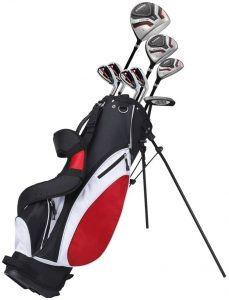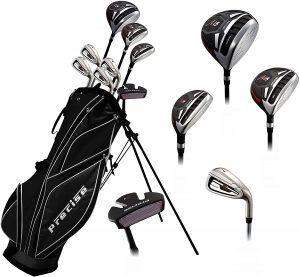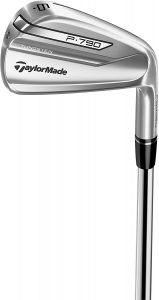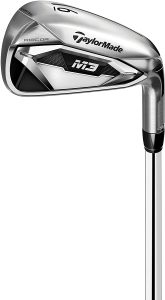You’ve been dreaming of this day for years! Junior has been swinging clubs from an early age, and you’re already preparing your early retirement on the strength of a commitment you’ve made in Junior golf. After all, no one can deal with Junior. There’s no way to do that! Seeking the right clubs for teens can be a challenge. Choosing the golf set they’re going to use in this trying moment, where they’re going to grow quickly and develop into friendly, mature people, isn’t going to be fun or easy. Here are the best golf clubs for teenager!
In many of our articles, especially product-based stories, we earn a small commission when readers purchase through our product links. This doesn’t affect which products are included in the articles. All of the products we highlight are recommended for their quality, performance, and overall reputation, regardless of any affiliate relationships.
| Best Golf Clubs For Teenager | Product Image | Expert Rating | Get It On Amazon |
|---|---|---|---|
| Precise Teenager Complete Golf Kit |  | Check Price | |
| Precise M5 Teenager Complete Set |  | Check Price | |
| TaylorMade P790 Irons |  | Check Price | |
| TaylorMade M3 and M4 Irons |  | Check Price |
Best Golf Clubs For Teenager: An Overview
This guide is meant for juniors who are rough. Twelve years old and up. In general, this post is not meant for younger golfers (e.g., ten or younger), but based on the junior’s height and strength, certain children under the age of 12 will be allowed to use normal adult irons.
Intermediate to intermediate junior golfers with a driving speed of ~85 mph (usually over 200 yards for their driver) will benefit from the advanced technologies used in modern adult golf clubs. Notice that while some of the big brands offer golf club sets that are expressly targeted for children or teens aged 12-15 years or older, they are usually cheaper and not of the same standard and do not work nearly as well as most modern adult clubs. In general, the price represents the standard of design, construction, and materials.
There are some decent choices for junior golf girls since most major golf brands offer high-quality ladies clubs that are a little smaller than standard adult clubs and fitted with shafts ideal for slower swinging speeds. Some junior golf clubs are not that different from women’s golf clubs: i.e., they are both lighter weighted and fitted with more compact, medium weight shafts that are ideal for both juniors and ladies. That’s why US Kids Golf now also offers the Lady Light Golf Clubs, which are 10% lighter than regular adult clubs. Callaway has a collection of exclusive ladies irons that are of very high quality.
Best Golf Clubs For Teenager: More Information
Club fittings should be considered for experienced juniors and are usually worth the investment to ensure that you get the best value for your junior golfer and maximize what is likely to be your junior’s most costly club package date. The fitting of the correct shaft is important for juniors who do not use standard adult clubs since the length and flex of the shafts greatly alter the clubs’ efficiency.
For more information on fitting junior golf clubs and a junior golf club size map, see our post on fitting junior golf clubs. Although this article focuses more on younger juniors, the advice and fitting map is also applicable and can include some general guidelines on how to calculate junior golf clubs.
Best Golf Clubs For Teenager: Reviews
If your teenage son or daughter has just recently started learning how to play golf, we think you’re probably hunting for the right golf clubs for teenagers. Golf clubs are the most critical or core aspect of this demanding activity, and it’s completely understandable that you want to get your hands on the best golf clubs for teenager.
Our Top Pick!

Product Name: Precise Teenager Complete Golf Kit
Product Description: The Precise teen package set is a perfect game improvement set of clubs for any golfer looking for more distance, forgiveness, and accuracy. This set was designed to help teens improve their game all-around. It includes all the clubs they need to get started!
-
Durability
-
Value For Money
-
Ease Of Use
-
Perfect For Teens
Overall
A. Best Golf Clubs For Teenager: Precise Golf
Precise has been serving the golf industry since 1987 when it began as a golf cart dealer under the name of Tartan Sports. Having changed their name and broadened their focus to include golf apparel, they now sell a full line of carts, clubs, bags, and accessories.
They have multiple sets of clubs targeted at and popular in the adolescent and junior golf markets, and we’re going to review two sets here.
1. Precise Teenager Complete Golf Kit
Unless Junior grows as quickly as a bamboo tree that has broken ground, the Exact Teenager Full package will last for many years as it is ideal for golfers between 5’0′′ and 5’8′′ large. Being a full package, Junior can enjoy the rewards of trying all the shots in the training videos he likes.
Both kinds of wood have 100% Graphite Shafts and Real Temper Steel Shafts. The normal length of the driver shaft is 43 inches. This extensive collection of clubs, as set out below, should make it easy for juniors to come as close to the adult experience as possible.
The lightweight structure of the set can assist junior golfers by contributing to their swinging pace. Besides being lightweight, the clubs are incredibly robust and forgiving. This is a perfect mix for someone who’s raising their golf experience. Although lightweight, there is enough weight in the irons to offer a strong feeling, but not too hard for ordinary teenagers to fight.
The regular putter has a strong mix of markings to better match the greens.
2. Precise M5 Teenager Complete Set
The Precise M5 Teenager is targeted at golfers between the ages of 13 and 16 and is between 5’1″ and 5’6″ tall. There are titanium inserts in the heads that will allow teenage golfers to strengthen their game with excellent input and an improved feel.
The 100% graphite shafts on the woods and the Real Temper steel shafts on the irons are regular issues. Compared with other clubs in this genre, the Exact M5 Teenager has a more professional look and sound.
Golfers that have shown to have more potential will benefit immensely from this collection. The input obtained from touch is of high quality and will allow the potential of Junior to develop rapidly.
Just what most teenage golfers crave, the no-fuss package of golf clubs. They are ready for action and provide adolescent golfers with a wide range of clubs but keep things easy enough to focus on their golf and not too much on the technology they provide.
B. Best Golf Clubs For Teenager: TaylorMade Irons
As one of the best-known luxury brands, TaylorMade offers many sets to cater to junior golfers’ transition to adult golfers. This is where our young golfers buy most of their tools.
They have a high degree of versatility in the configuration of teenage clubs, enabling the option of the loft, lying angle, shaft length, and flex in either steel or graphite.
3. TaylorMade P790 Irons
The first package we’ll look at is the P790, which is targeted at the game improvement industry and is used by all ranks in several levels of tournaments. The hollow body architecture is filled with “speed foam,” which enhances the forgiveness offered and generates the exceptional distance. MoI increase in 3-iron and 7-iron is due to the tungsten weights placed inside these irons. TaylorMade Pace Pocket technology increases the trampoline effect of the face by increasing distance.
Coat variations of matt chrome or black PVD finishes. The black PVD finish clubs come with color-coded black shafts that have the view of the Black Knight.
4. TaylorMade M3 and M4 Irons
And now the diamond in the crown of TaylorMade. The M3/M4 range is aimed at the game improvement market and makes almost all types of players very happy. Aesthetically, they are very appealing to the eye and give the golfer confidence at first sight. Faster ball speed is accomplished by a stiffer frame and a faster face developed with TaylorMade RIBCOR technology. Faster ball speed produces more reach, and that’s no exception. Forgiveness and distance are part of the kit, and no additional requests are required.
Size-wise, the head is larger than the previous M1 irons but comes in at a lighter weight. All the innovations and research that has gone into the TaylorMade clubs come at a premium but still worth testing out and investing in Junior’s future.
Best Golf Clubs For Teenager: Things To Consider
Lighter fabrics and improved aerodynamic characteristics can significantly help to improve clubhead speed and maximize enjoyment. The right shaft flex, weight, and grip would add up to fun hours rather than add to the tension levels.
1. Driver
Look for the biggest head available and the antitrust rules. All necessary assistance is needed and will be appreciated. The current limit is 460 cc, and most manufacturers, if not all, would have one available. If there is no one present in the brand that Junior has set his heart on, there is no risk in combining the products.
2. Hybrids
Manufacturers have kept the option of hybrids available for a long time, and there is a great explanation for this. Hybrids have the right properties for both iron and wood. The lower center of gravity makes it easier to reach than long irons, which have more depth and precision. What else does a fast-growing teenager want?
3. Irons
The wide-sole, cavity-backed irons have a lower center of gravity for higher ball trajectory and increased reach. Steer has been steering clubs away from the blade for now.
Look for clubs that deliver forgiveness and have outstanding reviews through your hands, and provide Junior the opportunity to enhance your game’s workability.
4. Wedges
A strong throwing wedge and a sand wedge are usually limited specifications. There is no harm in adding a few extra wedges to the bag to provide a learning opportunity with a better outcome. A lob wedge will push Junior to explore the green options and become a magician who shaves off the score.
5. Putter
Alignment plays a vital role in bringing the little white ball into the bucket and reducing the score. Junior also has to learn this tough aspect of the game. Provide him with a mallet putter, as the better balance would increase his confidence.
Best Golf Clubs For Teenager: Knowing The Clubs
Are you a novice in a fine game of golf? Enable us to introduce you to the golf clubs. In a standard golfer’s kit, there are many various styles of golf clubs. In reality, today, there are five types of clubs: wood (including the driver), iron, hybrid, wedge, and putter. What are these clubs like? What are the attributes and uses of each type of club?
There are various styles of golf clubs.
The following articles give golf newbies a general description of the shape and purpose of each type of golf club.
A. The Woods
The group of golf clubs named “woods” contains the driver and the fairway forest. (They are called woods even though their club heads are no longer made of wood.) The woods are the clubs with the widest heads (usually hollow, stretching a few inches from side to side and a few inches from front to back rounded lines) and the longest shafts. Golfers can swing them the quickest, and they’re used with the longest swings, even shots from the teeing ground.
B. The Irons
Iron comes in numbered sets, usually from 3-iron to 9-iron or pitching wedge. They have smaller clubheads than the trees, particularly from front to back, comparatively very low (leading to one of their nicknames: “blades”). Many irons have sturdy heads, but some of them are hollow. Irons have angled faces (called “loft”) engraved with grooves that help to hold the golf ball and give it a roll. They are usually used for shots from the fairway or for tee shots on shallow holes. If the number of iron increases (5-iron, 6-iron, etc., the loft increases as the shaft’s length decreases.
C. The Hybrids
Hybrid clubs are the newest golf club, group. They became popular right in the 21st century, although they existed several years before that. Think of a hybrid clubhead as a cross between wood and iron. Hence the name of “hybrid” (also sometimes called utility clubs or rescue clubs). Hybrids are numbered as irons (e.g., 2-hybrid, 3-hybrid, etc. and the number refers to the iron they substitute. That’s because hybrids are called “iron-replacement clubs,” meaning that many golfers find it easier to drive than the irons they substitute. But if a golfer uses hybrids, it is more likely to substitute long irons (2-, 3-, 4- or 5-irons).
D. The Wedges
The wedge group comprises the pitching wedge, the distance wedge, the sand wedge, and the lob wedge. Wedges are their sort of golf club, but they’re still a variation of irons because they’ve got the same clubheads as irons. They’re only more heavily angled to more lofts. Wedges are the highest-ranked golf clubs. They are used for shorter approach shots in greens, chips, pitches around greens, and sand bunkers. Continue to read
E. The Putter
Putters are the most advanced golf clubs and club that comes in the largest range of shapes and sizes. Putters are being used for, well, putting. They’re clubs that golfers use on putting greens, with the last strokes they’ve played on a golf hole-for knocking the ball into the hole.
There are more types of putters available on the market than any other club. That may be because choosing a putter is a very personal operation. There is no “right” putter here. It’s just the putter that’s perfect for you. Putters usually come in three types of clubheads and three sizes of lengths.
More Information
Clubheads: Clubheads may be a conventional blade, a heel-toe clubhead, or a clubhead. The typical blade is thin and shallow, generally with the foot’s shaft (although sometimes center-shafted). Heel-toe putters have the same basic outline as knives, but with additional weight on the heel and toe to add perimeter weighting and other construction tricks to help make clubs more “forgiving” mishits. Mallet putters have large clubheads that increase the forgiveness of bad touch. Mallets come in several shapes and sizes, some of them quite wide and very rare.
Lengths: normal length putters, also referred to as “conventional putters,” are about 32 to 36 inches long, from one end to the other. Standard or traditional length is the most common and the length that beginners can start with. Belly putters are the ones whose length allows the grip-end to come up-you guessed it-with the golfer’s belly. And the long putters (k and broomstick putters) are in the upper 40-inch, lower 50-inch range, allowing the golfer to stand upright. (Related: the duration of the butter-good what’s for you?)
Personality: But what putters boil down to is your personal preference. If you feel comfortable when you use a putter, the putter will usually work just fine. Too much faith, so getting a putter that feels good, that appeals to your mind, that you want, can only be a good thing.
No matter their size or form, both putters are built to start rolling the ball easily, with a minimum of backspin to prevent skipping or skidding. Almost all putters have a limited amount of loft (typically 3 or 4 degrees).
Best Golf Clubs For Teenager: Taking Care Of Clubs
Let’s hope you grasp how golf clubs operate now that it’s time to talk about caring for your clubs. Golf clubs are important for any golf player, newbie or experienced. They are costly machines and should be well handled. Keep reading to see the best ways to take care of your club, including how to prevent corrosion, clean rust, and the best place to store your clubs.
1. Storing The Clubs.
It’s important to make sure that you store your clubs in a safe location where no one can hurt or steal them. Golf clubs can be very expensive because if you were to replace a whole package, you might get a couple of hundred dollars back.
Theft isn’t the only thing you need to remember when storing your clubs. Hot temperatures, such as in your car boot, will loosen the glue that binds the grip and the clubhead in place.
Make sure you don’t store your clubs in damp weather, as rust will destroy your clubs. Make sure you give them a quick wipe before storage.
2. Cleaning Out Your Clubs.
Golf clubs can get pretty dirty on the course, particularly if you’ve been chipping away on the turf. Before putting them up, make sure you give them a comprehensive rinse.
The easiest way to clean golf clubs is to mix warm water and mild soap dishes and gently wash the clubs with a gentle brush (maybe a toothbrush) using that combination. When it’s clean, make sure you give them a dry towel before you put it away. You don’t want to get rusty clubs!
3. Rust
If it’s too late and you haven’t followed these directions, don’t worry. You should strip rust from your golf clubs. You’ll need fine steel wool, rough brush/toothbrush, wet and dry sandpaper, white bleach, metal polish, bucket, and some rags.
Place the white vinegar in the bucket and wet the steel wool in the vinegar. Rub it against the club shaft until the rust begins to fade. Use the sandpaper and apply weight if it still doesn’t work.
Next, scrub the head with the toothbrush and the remaining blood in the bucket. When the clubs are clean, use the metal polish to rub the rags on the club.
4. Golf Towel
If you want to keep your clubs clean and polished, be sure to make a golf towel part of your golf equipment. Whenever your clubs have sweat on them, just clean it off with your golf towel. Any towel would do, but you may also buy a specially tailored golf towel.
5. Headcovers
Be sure to use headgear on your woods, as they appear to be more fragile and easily harmed. Even transferring clubs from the sprint to the vehicle will cause harm the club heads, so some additional safety is good. You’re not going to require headcovers for your irons since they appear to be more durable and less delicate.
6. Grips
The grips should be inspected daily for cleanliness and wear. Some shiny places or holes are signs that you need to replace your handles. If your grips are broken, your golf game will be damaged. The grips are critical because you need a solid grip on the club to get the perfect shot.
You can pick them up on your own if you’re good with DIY, but some shops cost you a small fee.
Final Words
Stick to your budget without skimping on getting the best you can buy. Better clubs are going to yield better results. Know the beach house you’re hunting for? This could be your deposit. Pleasing an adolescent is never going to be an easy job. Choosing a set of golf clubs that can make the game simpler and more fun is much more challenging. Combining the two could turn into a complete nightmare.
We hope that we have sent you some advice to ease the heavy pressure that lies ahead of you. There are too many choices available and a difficult screening procedure to satisfy the exact criteria of Junior.
Premium brands all play in this room to train the teenager for club selection after graduating from the major league.
As this stage is fleeting and Junior is supposed to outgrow clubs within a few years, you have to make a tough decision based on your financial limitations and your hopes of early retirement depending on Junior’s success in the professional ranks. If the investments are not of concern, look at the premium suppliers for the right clubs.